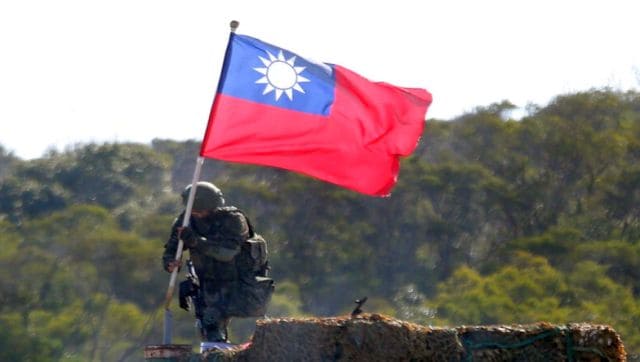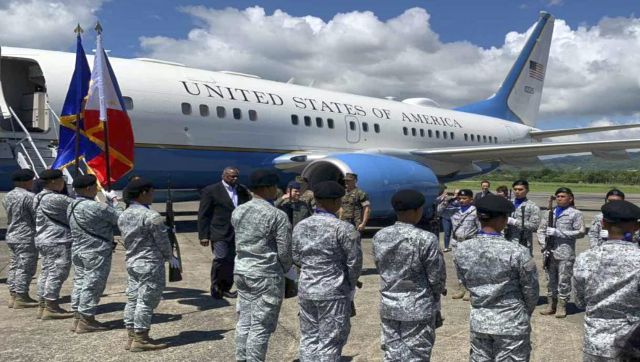The tensions between the United States and China continue to boil and the latest announcement by the Philippines will only up the ante. On Thursday, the
Philippines and the United States announced that the American military will gain access to four more bases
in the Southeast Asian nation under the Enhanced Defense Cooperation Agreement (EDCA) dating to 2014. The announcement was made during Defense Secretary Lloyd Austin’s visit to the nation, which began on Tuesday. The deal will allow Washington to position military equipment and rotate its troops into a total of nine military bases controlled by the Philippines. “The Philippines and the United States are proud to announce their plans to accelerate the full implementation of the Enhanced Defense Cooperation Agreement (EDCA) with the agreement to designate four new Agreed Locations in strategic areas of the country and the substantial completion of the projects in the existing five Agreed Locations,” a joint statement said. It was published on the websites of the US Department of Defense and on the Philippines’ Department of National Defense.
Also read: Explained: Why onions are making the Philippines cry
US bases in the Philippines The announcement of increased military bases in the Philippines comes at a time when the US Defence Secretary Lloyd Austin is in Manila to speak to his counterpart Carlito Galvez Jr. The location of the bases has not been announced as of yet. The statement only said that the new locations “will allow more rapid support for humanitarian and climate-related disasters in the Philippines, and respond to other shared challenges,” without specifying what those challenges are. However, speculation is rife that three of the bases could be on Luzon — an island on the northern edge of the Philippines. This, interestingly, is the only piece of land close to Taiwan, other than China. US-Philippines ties The military bases plan is part of America’s evolving relationship with the Southeast nation. The two nations have had a long and storied history with each other. US ties to the Philippines go back to 1898, when as part of the Treaty of Paris that ended the Spanish-American War, Madrid ceded control of its colony in the Philippines to the US. The Philippines remained a US territory until 4 July 1946, when Washington granted it independence – but a US military presence remained in the archipelago nation. In 1947, an agreement had given the US a 99-year lease on a number of Philippine military and naval bases. Pursuant to this, America maintained and operated major facilities at Clark Air Base until November 1991, and at Subic Bay Naval Complex and several small subsidiary installations in the Philippines until November 1992. The bases were shut down in the early 1990s after the Philippine Senate rejected an extension. As per a BBC report, the Filipinos had recently overthrown the dictatorship of Ferdinand Marcos, and sending the old colonial masters home would further cement both democracy and independence. [caption id=“attachment_12090772” align=“alignnone” width=“640”] Demonstrators hold banners as they protest against the visit of US Defense Secretary Lloyd Austin in metro Manila, Philippines. AP[/caption] Diplomatically too, the countries have had ups and downs. The Philippines under the previous regime of Rodrigo Duterte saw the nation moving away from Washington and cosying up to China. In 2016, he had announced the nation’s “separation” from the United States both in military and economic aspects, plunging bilateral ties to a new low.
Demonstrators hold banners as they protest against the visit of US Defense Secretary Lloyd Austin in metro Manila, Philippines. AP[/caption] Diplomatically too, the countries have had ups and downs. The Philippines under the previous regime of Rodrigo Duterte saw the nation moving away from Washington and cosying up to China. In 2016, he had announced the nation’s “separation” from the United States both in military and economic aspects, plunging bilateral ties to a new low.
However, with the ouster of Duterte and the new regime of
Ferdinand Marcos Jr
, ties are once again changing. Marcos, who won last May, has already met with US president Joe Biden twice during which he also reiterated that he couldn’t see a future for his country without its longtime ally — Washington. In November 2022, US vice president
Kamala Harris also visited the Philippines
to reiterate their ties. The Chinese angle The US has been pushing for better ties with the Philippines, keeping China in mind and its growing aggression over
Taiwan
. There have been growing fears in the region over a possible Chinese invasion of Taiwan, the island democracy that China claims as its territory. China’s Xi Jinping in October refused to rule out the use of military force to bring Taiwan under Beijing’s control, saying, “We insist on striving for the prospect of peaceful reunification with the greatest sincerity and best efforts, but we will never promise to give up the use of force and reserve the option to take all necessary measures.” [caption id=“attachment_12090872” align=“alignnone” width=“640”] There have been growing fears in the region over a possible Chinese invasion of Taiwan, the island democracy that China claims as its territory. AP[/caption] However, the Biden administration has been steadfastly supporting the island, stating that it would provide Taiwan with the means to defend itself without committing US troops. The US has an unofficial military presence in Taiwan, which has increased over the past two years. In 2021, it was revealed that Washington had increased its personnel from 20 personnel to 39. The tensions between the two over Taiwan have reached such a peak that top US general Michael A Minihan in a memo said that
open conflict between China and the United States
could be just two years away. “I hope I am wrong. My gut tells me will fight in 2025.” In his memo, he asks all air force commanders to prepare for the China fight. Even Republican leaders have written to Secretary of State Antony Blinken asking him to tell the Chinese leadership that their blatant aggression against Taiwan and India in the Himalayas is “unacceptable”. Blinken is visiting China on
5 and 6 of February
. And it’s not just Taiwan. Beijing has been flexing its muscles in the South China Sea. In March 2022, US Indo-Pacific commander Admiral John C Aquilino said that the Asian giant had fully militarised at least three of several islands it built in the disputed South China Sea, arming them with anti-ship and anti-aircraft missile systems, laser and jamming equipment and fighter jets. Also read: The consequences of China’s largest-ever military drills around Taiwan
Additionally, China has claimed sovereignty over Scarborough and other shoals, reefs and barren islands in the West Philippine Sea. It sits inside the Philippines’ exclusive economic zone but is also part of the broader South China Sea. And despite the 2016 Permanent Court of Arbitration at the Hague dismissing China’s claims, Beijing continues to exert its presence in the area. China hasn’t responded yet on the issue of the US military bases in the Philippines, but we can expect that it definitely won’t ease tensions between the two superpowers. With inputs from agencies Read all the Latest News
, Trending News
, Cricket News
, Bollywood News
, India News
and Entertainment News
here. Follow us on
Facebook
,
Twitter
and
Instagram
.
There have been growing fears in the region over a possible Chinese invasion of Taiwan, the island democracy that China claims as its territory. AP[/caption] However, the Biden administration has been steadfastly supporting the island, stating that it would provide Taiwan with the means to defend itself without committing US troops. The US has an unofficial military presence in Taiwan, which has increased over the past two years. In 2021, it was revealed that Washington had increased its personnel from 20 personnel to 39. The tensions between the two over Taiwan have reached such a peak that top US general Michael A Minihan in a memo said that
open conflict between China and the United States
could be just two years away. “I hope I am wrong. My gut tells me will fight in 2025.” In his memo, he asks all air force commanders to prepare for the China fight. Even Republican leaders have written to Secretary of State Antony Blinken asking him to tell the Chinese leadership that their blatant aggression against Taiwan and India in the Himalayas is “unacceptable”. Blinken is visiting China on
5 and 6 of February
. And it’s not just Taiwan. Beijing has been flexing its muscles in the South China Sea. In March 2022, US Indo-Pacific commander Admiral John C Aquilino said that the Asian giant had fully militarised at least three of several islands it built in the disputed South China Sea, arming them with anti-ship and anti-aircraft missile systems, laser and jamming equipment and fighter jets. Also read: The consequences of China’s largest-ever military drills around Taiwan
Additionally, China has claimed sovereignty over Scarborough and other shoals, reefs and barren islands in the West Philippine Sea. It sits inside the Philippines’ exclusive economic zone but is also part of the broader South China Sea. And despite the 2016 Permanent Court of Arbitration at the Hague dismissing China’s claims, Beijing continues to exert its presence in the area. China hasn’t responded yet on the issue of the US military bases in the Philippines, but we can expect that it definitely won’t ease tensions between the two superpowers. With inputs from agencies Read all the Latest News
, Trending News
, Cricket News
, Bollywood News
, India News
and Entertainment News
here. Follow us on
Facebook
,
Twitter
and
Instagram
.
)